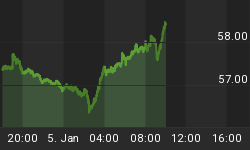Last week's outlook for precious metals can be summed up in a single sentence. We said:
"Based on our expectations, it appears the precious metals' bull run may be taking a rest for the time being as the entire sector continues to consolidate and feel for support."
Sure enough, gold spent most of the week navigating the $620-630 range. For silver, we specifically indicated the range between $13.30-13.50, just above the September high, as key support. Through midweek, silver was resilient above $13.70. On Wednesday we posted to the forums that even silver, which was looking technically stronger than gold, could still have "a long way down". Silver ultimately pierced resistance, temporarily hovering at the lower end of our range before plunging to close the week at $12.81.

It shouldn't be any surprise that, since it helped mark our "buy" signal in October, the FOMC figured into our warnings at a top. Last week we decidedly shifted our bias away from rate cuts to reflect a belief that the Fed is most likely inclined towards a rate hike when it does eventually change rates. We said:
"We'd been in "buy" mode since the October FOMC meeting until our precautionary warning last week. We'd implied in previous updates that the Fed's rhetoric was a smokescreen for rate-cutting aspirations. But, with the dollar having now come under serious pressure and scrutiny, it's clear the Fed will only cut rates in case of an emergency ... At the very least, a rate cut here would put the economic future of the country in the hands of the foreign governments. Considering that, with Europe and Japan tightening, steady fed funds are already a de facto rate cut, it starts to look like all the hawkish talk could have some substance."
This week saw data indicating that, over recent months, the Federal Reserve has increased bank reserves and total money supply as measured by M2 has increased by about 10%. This direct injection of liquidity echoes previous statements here to the effect that it's easier for the Fed to quietly inflate the money supply than make the high profile move of lowering headline interest rates, which would fan the economy but jeopardize the dollar. If the cause of the new money is strong demand and a healthy economy, as is currently being touted, this puts upward pressure on interest rates. But again, while we remain within the uncertainty of the substantial housing slowdown, it is easier for the Fed to quietly inflate money supply to meet demand rather than damage the economy with higher rates. Ultimately, if the data continues to unfold as projected by the Fed, bias would have to be toward an eventual rate hike, either to reabsorb liquidity, or to cool an economy that's exceeded sustainable levels of growth.
Though the Fed won't step in to cut rates anytime soon, and we can expect precious metals to continue trading in a consolidation pattern, seeking firm support levels, this is not the end of the long term precious metals bull! As we indicated last week, there is still a bullish fundamental picture behind gold and silver and, if nothing else, this alone should put a floor under the decline. Any concession from China, such as a yuan revaluation, that would begin to reverse the current trade imbalance, would ultimately strengthen the dollar, but, to the extent that this does not appear likely, the dollar will remain under significant pressure. As Alan Greenspan discussed earlier this week, in the intermediate term, foreign governments will probably continue to diversify out of their dollar reserves and, though, dollar selling will not necessarily translate into purchases of gold, it should eventually contribute to stabilizing the decline in the metals.
With the long-term picture still in tact, potential intermediate term catalysts that could restart the rally in metals are shaping up even now. First, despite the reasons listed above, contained inflation opens the door to potential rate cuts by the Fed should catastrophic events occur. If the housing slowdown does ultimately spill over into the rest of the economy, particularly in the form of mortgage defaults and foreclosures, the Fed could be forced into further increasing liquidity. Though an agreement with China could help prevent the dollar from spiraling to record lows, a recession in the U.S. would probably spur buying in commodities and specifically precious metals. Oil is also back in the news recently after OPEC announced production cuts for next year. A steady rise in oil, which is quite possible as we approach start to approach summer, can also have a beneficial impact on precious metals and a devastating effect on the consumer-driven economy. Obviously, terror attacks or violence could upset equities markets and send money back to the metals.
Looking at the week ahead, markets will get another take on inflation in Tuesday's PPI as well as a window into the housing market in the form of new housing starts. Other crucial data include final GDP, Philly Fed, jobless claims, and money supply figures, all on Thursday.















